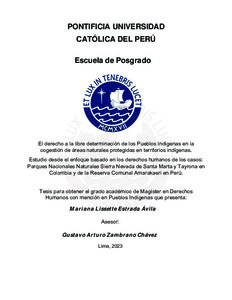| dc.contributor.advisor | Zambrano Chávez, Gustavo Arturo | |
| dc.contributor.author | Estrada Ávila, Mariana Lissette | |
| dc.date.accessioned | 2023-11-14T14:33:04Z | |
| dc.date.available | 2023-11-14T14:33:04Z | |
| dc.date.created | 2023 | |
| dc.date.issued | 2023-11-14 | |
| dc.identifier.uri | http://hdl.handle.net/20.500.12404/26413 | |
| dc.description.abstract | Los mecanismos de conservación de la biodiversidad denominados áreas naturales protegidas
han sido duramente criticados a nivel mundial por incurrir, frecuentemente, en numerosas
violaciones de derechos de los Pueblos Indígenas ya que, en todo el mundo, un alto porcentaje
de las áreas protegidas se han establecido en territorios habitados por Pueblos Indígenas.
Ante este desafío, diversos países en América Latina han desarrollado mecanismos de cogestión
de áreas naturales protegidas que buscan establecer un diálogo entre la visión de manejo del
territorio de los Pueblos Indígenas y la del Estado.
Los programas de cogestión de áreas naturales protegidas son diversos, pero en su mayoría
surgen para dar respuesta a la demanda de los Pueblos Indígenas de garantizar la protección de
sus derechos, cambiando el paradigma de los modelos de conservación controlados totalmente
por el Estado, por modelos que se muestran más incluyentes y que buscan compartir la
administración con las comunidades que habitan estos territorios.
El objetivo de esta investigación es medir el nivel de protección del derecho a la libre
determinación de los Pueblos Indígenas en el marco de los programas de cogestión de áreas
naturales protegidas. Para hacer este análisis se parte del enfoque basado en derechos humanos
y se analizan dos casos de estudio: los Parques Nacionales Naturales de la Sierra Nevada de
Santa Marta y Tayrona en Colombia y la Reserva Comunal Amarakaeri en Perú.
Esta investigación propone una metodología cuantitativa para medir el nivel de protección del
derecho a la libre determinación que ofrece resultados comparables. A través de esta
metodología se mide la protección de este derecho en tres niveles 1) marco normativo nacional;
2) programa de cogestión del área protegida y 3) percepción de los Pueblos Indígenas. Esta
metodología también permite identificar si existe una brecha en la garantía del derecho a la libre
determinación de los Pueblos Indígenas entre los tres niveles de análisis. | es_ES |
| dc.description.abstract | Biodiversity conservation mechanisms known as natural protected areas have been severely
criticized worldwide for frequently incurring in numerous violations of the rights of Indigenous
Peoples, since a high percentage of protected areas around the world have been established in
territories inhabited by Indigenous Peoples.
Faced with this challenge, several countries in Latin America have developed mechanisms for
co-management of natural protected areas that seek to establish a dialogue between the
Indigenous Peoples' vision of territorial management and that of the State.
The programmes of co-management of natural protected areas are diverse, but most of them
have arisen in response to the demand of Indigenous Peoples to guarantee the protection of their
rights, changing the paradigm of conservation models controlled entirely by the State, for models
that are more inclusive and that seek to share the administration with the communities that inhabit
these territories.
The objective of this research is to measure the level of protection of the right to self-determination
of Indigenous Peoples in the framework of co-management programmes in natural protected
areas. This analysis is based on a human rights-based approach and analyzes two case studies:
the Sierra Nevada de Santa Marta and Tayrona National Parks in Colombia and the Amarakaeri
Communal Reserve in Peru.
This research proposes a quantitative methodology to measure the level of protection of the right
to self-determination of Indigenous Peoples that offers comparable results. Through this
methodology, the protection of this right is measured at three levels 1) national legal framework;
2) co-management programme of the protected area and 3) perception of the Indigenous
Peoples. This methodology also allows us to identify whether there is a gap in the guarantee of
the right to self-determination of Indigenous Peoples between the three levels of analysis. | es_ES |
| dc.language.iso | spa | es_ES |
| dc.publisher | Pontificia Universidad Católica del Perú | es_ES |
| dc.rights | info:eu-repo/semantics/openAccess | es_ES |
| dc.rights.uri | http://creativecommons.org/licenses/by-nc-sa/2.5/pe/ | * |
| dc.subject | Pueblos indígenas--Relaciones gubernamentales--Perú | es_ES |
| dc.subject | Pueblos indígenas--Relaciones gubernamentales--Colombia | es_ES |
| dc.subject | Áreas protegidas--Perú | es_ES |
| dc.subject | Áreas protegidas--Colombia | es_ES |
| dc.subject | Autodeterminación nacional--Perú | es_ES |
| dc.subject | Autodeterminación nacional--Colombia | es_ES |
| dc.title | El derecho a la libre determinación de los Pueblos Indígenas en la cogestión de áreas naturales protegidas en territorios indígenas. Estudio desde el enfoque basado en los derechos humanos de los casos: Parques Nacionales Naturales Sierra Nevada de Santa Marta y Tayrona en Colombia y de la Reserva Comunal Amarakaeri en Perú | es_ES |
| dc.type | info:eu-repo/semantics/masterThesis | es_ES |
| thesis.degree.name | Maestro en Derechos Humanos con mención en Pueblos Indígenas | es_ES |
| thesis.degree.level | Maestría | es_ES |
| thesis.degree.grantor | Pontificia Universidad Católica del Perú. Escuela de Posgrado | es_ES |
| thesis.degree.discipline | Derechos Humanos con mención en Pueblos Indígenas | es_ES |
| renati.advisor.dni | 10789717 | |
| renati.advisor.orcid | https://orcid.org/0000-0003-0274-6706 | es_ES |
| renati.author.pasaporte | G09624668 | |
| renati.discipline | 421847 | es_ES |
| renati.juror | Urteaga Crovetto, Patricia | es_ES |
| renati.juror | Zambrano Chávez, Gustavo Arturo | es_ES |
| renati.juror | Segura Urrunaga, Frida Isabel | es_ES |
| renati.level | https://purl.org/pe-repo/renati/level#maestro | es_ES |
| renati.type | https://purl.org/pe-repo/renati/type#tesis | es_ES |
| dc.publisher.country | PE | es_ES |
| dc.subject.ocde | https://purl.org/pe-repo/ocde/ford#5.06.00 | es_ES |







